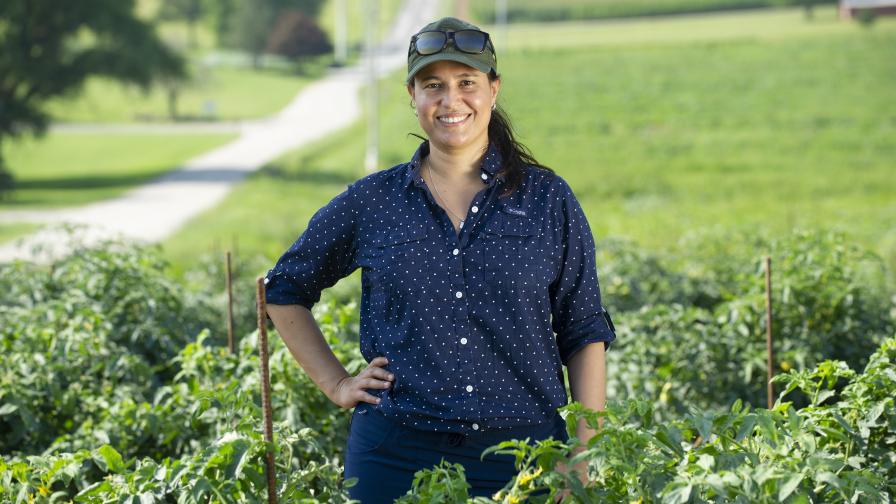Peach Grower Rises Above the Freeze — Here’s How They Did It

Co-Owner Drew Echols, seen here last fall, credits the 1,400-foot elevation of Jaemor Farms with saving 30% of his peach crop this season.
Photo by Carol Miller
Drew Echols is crediting the lofty altitude of his northeast Georgia farm —nearly 1,400 feet — for saving some of his 150-acre peach crop this season. While most peach growers in the southern two-thirds of Georgia are dealing with up to 95% crop loss after a mid-March freeze, Echols’ operation — Jaemor Farms in the Blue Ridge Foothills of Lula, GA — is expecting to net 30% of its expected production. Height made right in this case.
“It’s just the way the land and climate are in the state of Georgia,” Echols says. “There’s not a whole lot of peaches grown in Virginia or Pennsylvania, but from what I’m being told, they’ve got a full crop. My farm actually lines up more with those northern climates than with even the guys in middle Georgia. Those farms are 500-, 600-, 700-foot elevation, and my farm is at 1,300-, 1,400-foot in elevation.”
At twice the altitude of farms to the south, Jaemor Farms better averted unusually warm February temperatures that would lay the groundwork for disaster a month later. On five days between March 14 and March 21, with most of the state’s peach trees having blossomed prematurely, freezing temperatures hit the entire region.
“It’s supposed to be that cold in March,” Echols says. “It’s just not supposed to be that warm in February.”
Growers in middle Georgia — facing the same freezing temperatures as Echols but with their fruit further along in development — took the biggest hit. “Their damage was a little bit worse,” Echols says. “Actually, a lot worse than mine.”
Not that Jaemor Farms went unscathed. “We were way ahead of schedule as far as bloom time — three weeks ahead,” Echols says. “We kind of knew we were very, very susceptible to a freeze, as warm as it had been in February. This is the earliest our peaches have ever gotten killed.”
STATEWIDE DIAGNOSIS
American Fruit Grower peach columnist Dario Chavez foresees, at best, only 10% of the state’s total crop will be harvested. At issue now, he says, are the freeze’s aftereffects.
“Some of the possible effects you can still see in a fruit that may have been affected in some way is split pits, internal damage, and sometimes smaller size as the embryo inside of the fruit was killed during the freeze,” Chavez, an Associate Professor in Peach Research and Extension at the University of Georgia, says.
Echols confirms his peaches have a significant amount of freeze damage, specifically split seeds and actual cracks in the fruit. “We are culling more fruit than ever, especially after rain events,”
he says.
Among his 30 varieties of peaches, about eight of them “performed well” despite the freeze event, Echols says, including ‘July Prince’, ‘Scarlet Prince’, ‘Zee Lady’, ‘September Sun’, and ‘Big Red’. “The list is way too long of the ones that didn’t do well,” he says.
CUSTOMER CONNECTIONS
If any farm can offset a disappointing crop, it would be Jaemor Farms. Specializing in direct sales and agritourism, the 510-acre operation attracts more than a million customers per year. A 6-acre corn maze, built in 2006, alone attracted 40,000 visitors last fall and nearly 30,000 the previous year.
“I feel like we’ve done a pretty decent job of starting out retail-minded and then getting into the agritourism side of things, with field trips, and corn mazes, and all that kind of stuff,” Echols says. “When that happened around 2006, that’s when everything just started going gangbusters.”
Peach production doubled from 40 acres to 80 acres after 2006 and to its current 150 acres. Strawberry production opened at 3 acres in 2011 and now stands at 25 acres. Other prominent crops include 200 acres of pumpkins and 40 acres of summer vegetables, including beans, tomatoes, sweet corn, and melons.
“You sort of have to do it all,” Echols says. “I don’t think I could farm like this in north Georgia if I didn’t have that retail component and the agritourism component.”










